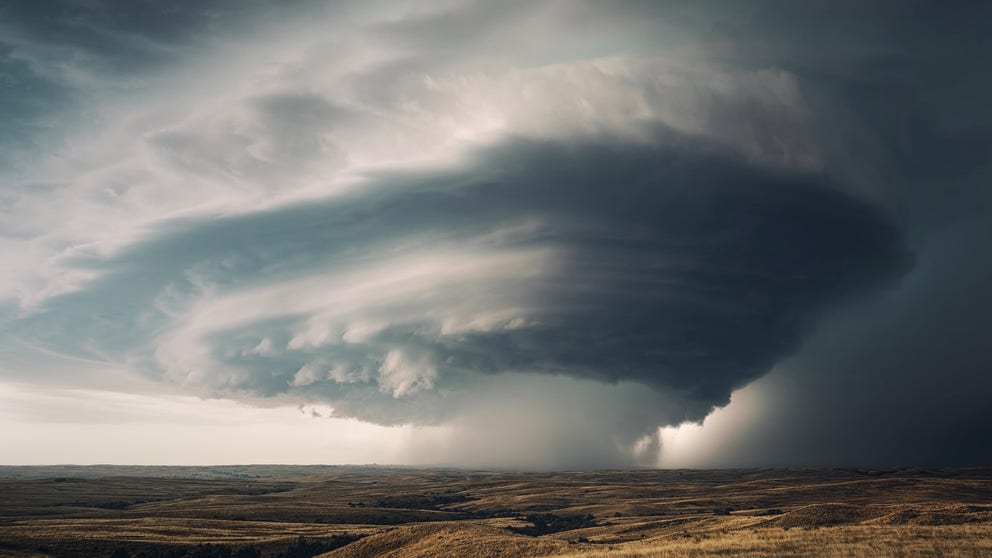We all love the movie 'Twister,' but is it scientifically accurate?
The highly popular weather-related movie was based on the work of scientists at NOAA’s National Severe Storms Laboratory, and while it got some things right, it also got a lot of things wrong.
How do tornadoes form?
Regardless of their strength and how long they stay on the ground, all tornadoes require the same atmospheric conditions in order to form.
Now 27 years old, the 1996 blockbuster movie "Twister" is arguably the most popular weather-related film of all time (sorry, "Sharknado"), but have you ever considered its scientific accuracy?
Perhaps you remember a (computer-generated) cow being tossed through the air and the high-speed storm chasing involving a pickup truck.
It certainly seemed like Hollywood science fiction at the time, but the movie was actually based on the work of scientists at NOAA’s National Severe Storms Laboratory (NSSL).

The day they arrived in Oklahoma to begin filming, most of the "Twister" cast, including star Bill Paxton, went storm chasing with NOAA researchers participating in the VORTEX field project designed to study tornadoes like this one. Though the cast didn't see any tornadoes that day, VORTEX scientists took measurements of this one that occurred June 2, 1995, south of Dimmitt, Texas.
(NSSL / NOAA)
"In an effort to collect weather data from inside a tornado, NOAA researchers created the TOtable Tornado Observatory (TOTO), named after Dorothy’s little dog from the movie ‘The Wizard of Oz,’" NOAA said. "During the 1970s and ‘80s, several groups from NSSL and the University of Oklahoma tried to deploy TOTO, but never scored a direct hit."
According to NOAA, TOTO was retired in 1987, but not before it inspired screenwriters Michael Crichton and Ann Marie Martin to develop a story around a similar device.
In "Twister," "Dorothy" was a barrel similar to TOTO. It was designed to release hundreds of sensors into the center of a tornado and send the data back to the weather researchers on the ground, Bill Harding and Dr. Jo Harding (played by actors Bill Paxton and Helen Hunt, respectively).
For added Hollywood drama, a similar device named "D.O.T. 3" was also attempted to be deployed by a competing team of storm chasers in the movie.
Props of both Dorothy and D.O.T. 3 are on display at the National Weather Center in Norman, Oklahoma, alongside TOTO, a red 55-gallon barrel outfitted with weather sensors that was used by NOAA researchers to study tornadoes.
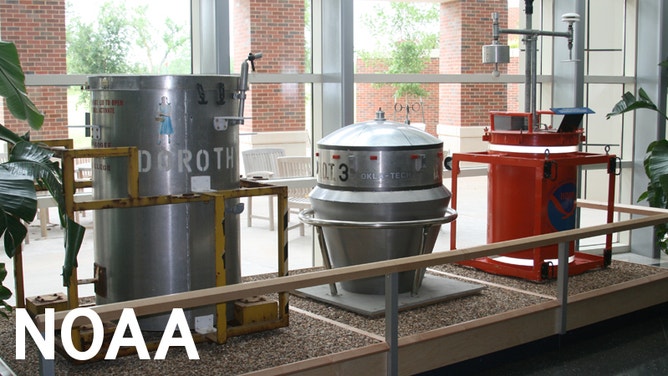
TOTO, a red 55-gallon barrel outfitted with weather sensors, was used by NOAA researchers to study tornadoes. Dorothy and D.O.T. 3 are props based on TOTO and were used in the movie "Twister." All three are on display at the National Weather Center in Norman, Oklahoma.
(NOAA/NSSL)
What’s scientifically accurate about ‘Twister’
The "Twister" screenwriters, as well as producers Steven Spielberg and Kathleen Kennedy, consulted with scientists from NSSL in Norman, Oklahoma, to make sure their script was as realistic as possible.
"Several actors, especially Bill Paxton, spent a lot of time at NSSL to get a feel for the coordination needed to be successful in tornado experiments," NOAA said. "Actual tornado researchers took many of the actors out on a real tornado chase."
Harold Brooks, a research meteorologist with NSSL, served as an advisor on "Twister." He provided input to the script, advised producers about severe weather safety and helped create believable backgrounds for some of the movie’s scenes, according to NOAA.
For example, a satellite called GOES 8 was mentioned at the start of the movie. This was, in fact, a real satellite used by NOAA from 1994 to 2004. Much of the meteorological jargon, like "the cap is breaking" and "the wind shear is veering," was accurate as well.
Dr. Jonas Miller, the leader of the rival storm chasing team in the film (played by actor Cary Elwes), and his team were taken out by the final tornado in "Twister." This was eerily similar to the 2.6-mile-wide EF-3 tornado that struck El Reno, Oklahoma, on May 31, 2013, 17 years after the movie was released.
HOW ARE TORNADOES RATED? THE ENHANCED FUJITA SCALE EXPLAINED

This photo shows EF-3 damage to a metal and steel building just north of Interstate 40, or about 5 miles east-southeast of El Reno, Oklahoma, in Canadian County. A progressive collapse of rigid frames occurred with the metal and steel building.
(National Weather Service)
Many highly experienced storm chasers were caught off guard by the real-life El Reno tornado, including a crew from The Weather Channel, just like the huge twister toward the end of the movie that suddenly changed its course, killing Jonas and some of his fellow chasers.
Much of Jonas’ presence in "Twister" brought up the debate about scientists chasing storms for money or for the goal of conducting beneficial research to better understand severe weather. Although it was highly dramatized in the movie, this element of storm chasing continues to this day among the meteorology community.
Today, tornado researchers have ground-based and aerial instruments that are smaller and easier to deploy in large numbers to sample tornadoes than those depicted in "Twister."
"The ultimate goal in science fiction and in real-life research remains the same: to measure the weather in and near a tornado at the ground, adding valuable pieces to the tornado puzzle, improving prediction and hopefully saving more lives," NOAA said.
What’s scientifically inaccurate about ‘Twister’
When Bill and Jo got caught inside the twister, it had a clear "eye" in the center. Although this can be true, most larger tornadoes have multiple vortices embedded within them.
HOW LONG DO TORNADOES LAST AND HOW DO THEY FORM?
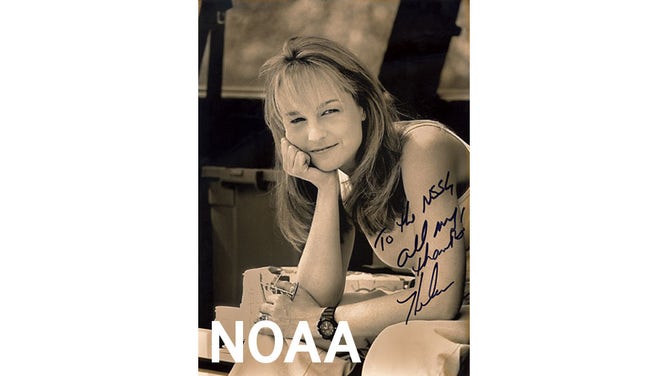
"Twister" co-star Helen Hunt gave this autographed photo to NOAA's National Severe Storms Laboratory staff during filming.
(NOAA/NSSL)
Additionally, "Twister" seemed to portray that a green sky means a tornado is headed your way, which is not always true. The sky actually turns green because of light scattering through a tremendous amount of hail and water in a thunderstorm; storms that produce tornadoes typically have enormous amounts of hail and rain to give the sky that green tint.
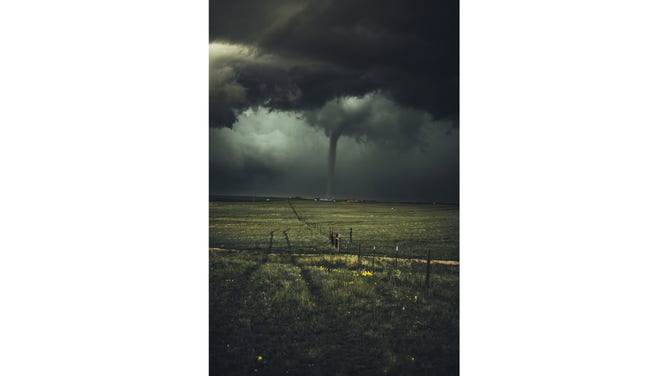
(Photo by Nikolas Noonan on Unsplash)
Meteorologists also can’t determine the strength of a tornado simply by looking at it, as was the case in the movie. In the opening scene, when Jo’s dad got sucked out of the storm cellar, he mentioned that the TV said an F-5 tornado was on the way. A tornado’s strength is not known until after National Weather Service meteorologists go out and survey the damage in the days following the twister.
What’s more, an F-5 tornado technically wasn’t possible because the film was set in June 1969, while the Fujita Scale wasn’t developed until two years later in 1971.
"Twister" also had notable issues with the way the characters sought shelter when tornadoes were approaching them. For example, Bill and Jo took cover under a bridge during the movie’s first "present-day" tornado. According to the NWS, you should never seek shelter under a bridge or overpass because it provides virtually no protection.
THIS IS WHAT YOU SHOULD DO IF YOU ARE DRIVING AND THERE IS A TORNADO ON THE GROUND
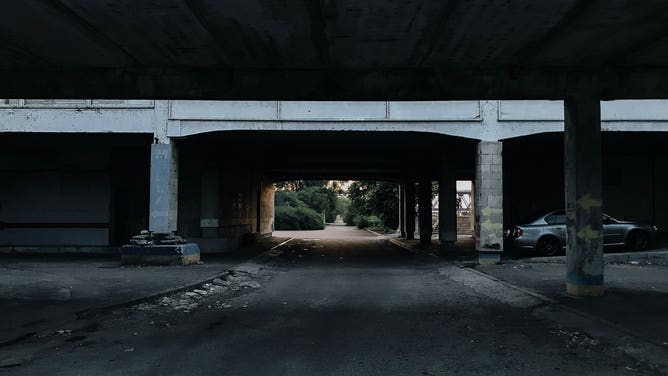
(Photo by Kyrylo Kholopkin on Unsplash)
Later in the film, when a twister struck the drive-in movie theater, the group ran to a large hangar for protection. However, big, open rooms such as hangars or gymnasiums should not be used as a tornado shelter because they are not sturdy enough to withstand the powerful winds or lofted debris.
Fortunately, tornadoes are not known to jump back and forth and zig-zag as Hollywood depicted, so that’s likely not a scenario one would encounter in real life.
